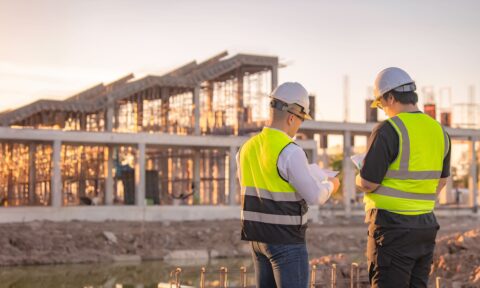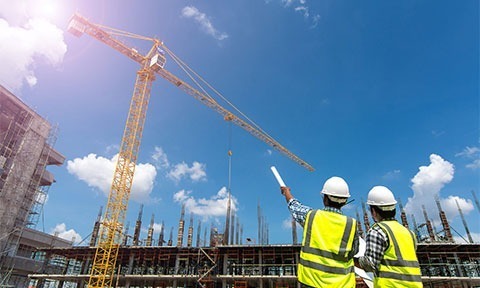Design of Lightweight Structures
- Course focuses on lightweight structures for high strength-weight ratio in structural engineering and transport applications.
- Engineers and scientists involved in composite structures design, operation, and assessment should attend.
- Materials with high strength-weight ratio like aluminium and fibre-reinforced plastics are used in lightweight structures.
- Lectures cover topics like composite materials, design for buckling, and application of composites in industrial structures.
- Lecturers have extensive experience in structural engineering, composite materials, and offshore wind turbine design.
Overview
The Lightweight Structures Training course focuses on the selection of materials with high strength-weight ratios to create cost-effective, high-performance structures. It emphasizes minimizing weight without significantly increasing fabrication costs, particularly in structural engineering and transport applications. The course covers the use of strong but lightweight materials like aluminium alloys and fibre-reinforced plastics in structures. Targeted at engineers and scientists involved in composite structure design, the program includes lectures on composite materials, analysis, design, and applications in industrial structures by experienced industry professionals.
Who should attend
Engineers, Scientists
Course Content
ABOUT THE COURSE
The modern trend in selection of materials for high strength-weight ratio is governed by the growing need for low-cost high performance structures. The amount of material has a direct bearing on cost. Therefore the first step towards the cheapest structure is to minimise the weight without disproportionately affecting the fabrication cost. The main application for materials possessing high strength-weight ratio are in structural engineering, transport and portable appliances. Cost savings is one of the criteria for successful structural engineering and transport application. The use of strong but light-weight members helps to achieve this in that the overall stress levels in a construction are reduced together with handling, manipulation and pay-load cost. These factors are important in such applications as bridges, ships, high speed vessels, rail and transport carriers. As light-weight applications mean the use of strong but low-density materials, alloys of aluminium are generally used. However, new approaches in fabrication techniques are leading to high use of fibre-reinforced plastics. This course will deal mainly with structures with FRP/GRP materials and aluminium.
WHO SHOULD ATTEND
Engineers and scientists involved in the design, operation and assessment of composite structures and their associated equipment. Personnel from oil companies, consultancy organisations, classification societies and certifying authorities will benefit from attending this course.
PROGRAMME
Day 1
08:30 – 09:00 Delegate Registration
09:00 – 10:30 Lecture 1: Introduction to Composite Materials – N. Sampathkumar
10.30 – 11:00 Break
11:00 – 12:30 Lecture 2: Fundamentals of Composite Structures – N. Sampathkumar
12:30 – 13:30 Lunch
13:30 – 15:00 Lecture 3: Selection of Composite Materials – N. Sampathkumar
15:00 – 15:30 Break
15:30 – 17:00 Lecture 4: Analysis & Design of Composite Structures – N. Sampathkumar
Day 2
09:00 – 10:30 Lecture 5: Introduction to Aluminium Structures – P. K. Das
10:30 – 11:00 Break
11:00 – 12:30 Lecture 6: Design for Buckling & Strength – P. K. Das
12:30 – 13:30 Lunch
13:30 – 15:00 Lecture 7: Application of Composites in Industrial Structures – I – N. Sampathkumar
15:00 – 15:30 Break
15:30 – 17:00 Lecture 8: Application of Composites in Industrial Structures – II – N. Sampathkumar
17:00 Closure
ABOUT THE LECTURERS:
Narasimhan Sampathkumar
Narasimhan Sampathkumar joined Atkins in July 2014. Prior to that, he worked for OWEC Tower AS in Norway since 2012. As a senior Structural engineer, he was involved in conceptual, feed and detailed design of jacket structures for offshore wind turbines and provided engineering support for tender submissions. Performed R & D projects to study dynamic response, establish load-exchange process with wind turbines, performing fatigue/ultimate analysis, etc. He also comes with 3 years of onshore wind turbine design, certification and product management experience prior to 2012. Overall, he comes with 12+ years of structural engineering experience, especially in Finite element methods and holding a PhD from the University of Southampton.
Key Experience:
• 6+ years of experience in Wind Turbine and Offshore sub-structural design, familiarity with turbine loads, aerodynamics & control simulations, strength calculations of wind turbine components and jacket structure, power performance, turbine testing & measurement, IEC61400 and DVN GL Codes for Certification process
• Lead R&D and Engineering projects for technical assessment of Offshore wind turbine jacket sub-structure comprising, aerodynamic, aero-elastic and structural calculations
• Expertise on Analysis and Strength calculation of various components of wind turbines, including blades, castings, gear box-generator and tower structure, as per IEC61400 / GL guidelines
• Strong leadership skills with Technical/People management, mentoring and proactive role in strategic decisions, active team player
• Eight publications in key international journals and conferences
Present role at Atkins: As a Principal Structural Engineer in the Renewable Energy Group, Dr Narasimhan is playing the role of a reviewer and approver for Atkins offshore substructural design for various offshore wind farm projects. This involves design basis / brief documents, establishing technical governance, loadexchange process, technical calculations and liaising with alliance partners and stakeholders in the project. Mentoring of the engineering team for establishing technical excellence within the group. Dr Narasimhan holds a PhD in “Fluid Structures Interactions Research Group”, the University of Southampton, an MSc (Eng) in Structural
Engineering from the Indian Institute of Science in
Bangalore, India and a BEng in Civil Engineering from the Madras University in Chennai, India.
Purnendu K Das
Purnendu K Das BE, ME, PhD, C.Eng, C.MarEng, FRINA, FIStructE, FIMarEST has been the Director of ‘ASRANet Ltd’ (an ISO 9001-2008 certified company) since February 2006. He retired as a Professor of Marine Structures in the Department of Naval Architecture & Marine Engineering at the University of Strathclyde, UK. Past EU projects were MARSTRUCT (a network of excellence on Marine Structure) and SHIPDISMANTL (a cost effective and environmentally friendly dismantling of ship structures). Past industrial projects included work from the UK Health and Safety Executive (HSE), MoD UK, Subsea-7 UK, Shell, Woodgroup and US Navies etc. He was the principal investigator of many EPSRC projects. Before joining the University of Glasgow in 1991 he worked with British Maritime Technology as Principal Structural Engineer (1984-91). He is the author of more than 250 publications, including contract reports and more than 60 journal papers and is a member of the editorial boards of the ‘Journal of Marine Structures’, ‘Journal of Ocean and Ship Technology’ and ‘Journal of Ocean and Climate System’ amongst others. His areas of research include limit state design and analysis & reliability analysis of ship & offshore structures. Purnendu Das has wide ranging industrial and academic contacts
and has adised and supervised 20 PhD students, to his credit. Details of visits and collaborations include his various sabbatical study periods spent at University of California, Berkeley, USA (July – September 1996), at Lloyd’s Register of Shipping (August 1997), Kockums Ltd (July 1998) and spent some time at Instituto Superior Técnico (IST), Lisbon (July 2000). He has been running various successful CPD courses which are attracting many people from different industries. These courses are on ‘Fatigue & Fracture Analysis’, ‘Ships at Sea’, ‘Advanced Analysis and Design of Offshore Structures’, ‘Offshore Floating System Design’, ‘Structural Response under Fire and Blast Loading’ and ‘Design of Pipelines and Risers’ amongst others. He was a member of ISSC (International Ship and Offshore Structure Congress) for the periods of 1991-97 and 2003-2006. He was a member of the OMAE (Offshore Mechanics and Arctic Engineering) Organising Committee on ‘Safety and Reliability’. He has organised six ASRANet International onferences in 2002 (Glasgow), 2004 (Barcelona), 2006 (Glasgow), 2008 (Athens), 2010 (Edinburgh) and 2012 (London) where a large number of participants from various countries attended. The theme of the conference is the integration of risk, advanced structural analysis and structural reliability analysis as applicable to various engineering structures. He is now the member of “Research committee” of the Institution of Structural Engineers (I.Struct.E) London.



